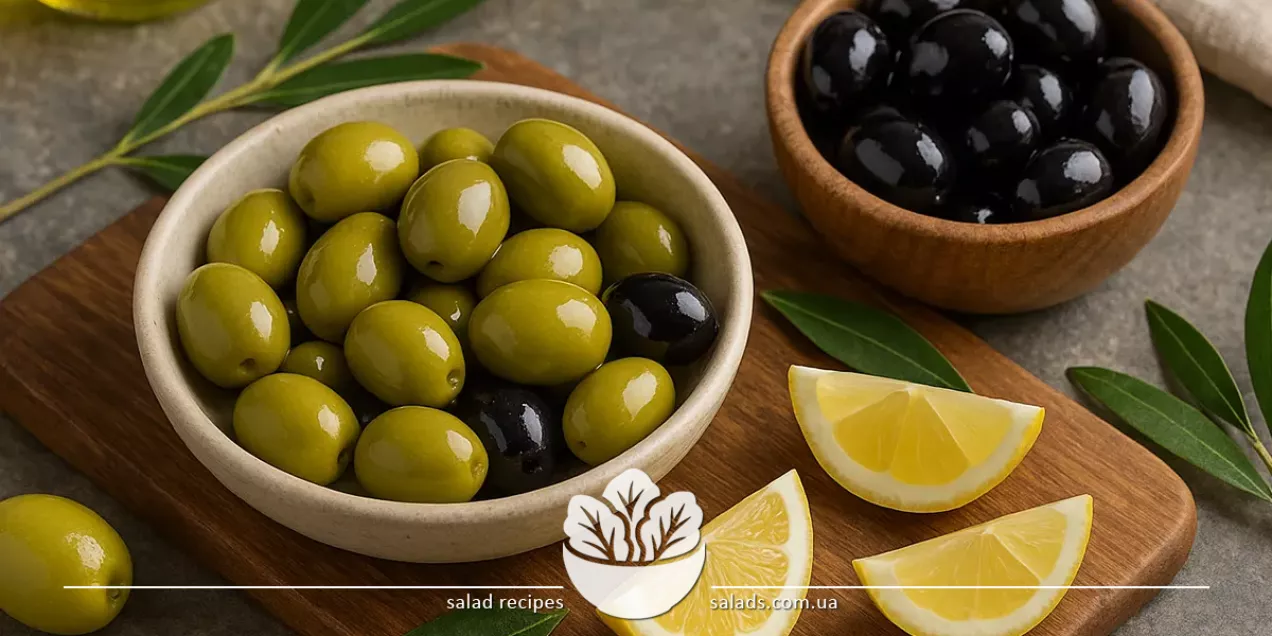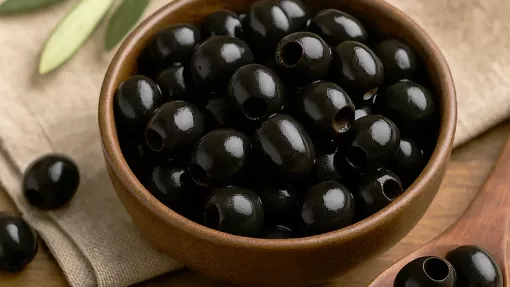Olives

Olives are the fruit of the olive tree, with a rich history and an important role in Mediterranean and other cuisines. They are widely used both fresh and preserved. Depending on the variety, olives vary in color, taste, and texture, which determines how they are used – from simple appetizers to complex sauces and marinades. Among fruits, olives stand out for their rich flavor and health-promoting properties, such as antioxidants and healthy fats. They are added to salads, pasta, pizza, and also used to make olive oil, which is considered one of the healthiest oils.
Different Types of Olives
Green Olives: Characteristics and Uses
Green olives are harvested before full ripeness and have a more intense and tangy flavor. Due to their lower oil content, green olives have a firmer and crunchier texture. They are widely used in Mediterranean cuisine as a snack and added to salads, pizza, sauces, and marinades. Before consumption, green olives are often treated – soaked in brine or saline solution to reduce bitterness and enhance their flavor. A distinctive feature of green olives is their ability to pair well with other ingredients: cheese, herbs, lemon, or garlic. For example, in classic Greek salads, green olives create a delightful contrast with tomatoes, cucumbers, and cheese. They are also used in meat marinades, adding spiciness and freshness to dishes. Combined with herbs such as rosemary, oregano, or basil, green olives reveal new flavor dimensions. Their bright green color makes them ideal for creative appetizers and canapés. They are often stuffed with almonds, peppers, or cheese, making dishes more vibrant and flavorful. Besides their culinary value, green olives are rich in vitamins E and A, as well as antioxidants that promote skin health and reduce inflammation.
Black Olives: Flavor Profile and Applications
Black olives are fully ripe fruits with a softer texture and sweeter flavor compared to green ones. They often undergo fermentation or long-term soaking in brine, giving them a richer and deeper aroma. Black olives are widely used in preparing salads, pasta, sauces, and added to pizza and other Mediterranean dishes. Thanks to their softer texture, black olives pair easily with a variety of ingredients – tomatoes, basil, capers, and garlic. They are often a key component of classic dishes such as tapenade – a paste made from olives, capers, anchovies, and olive oil. Preserved in jars or oil, black olives retain their richness and depth of flavor, making them popular among gourmets. In addition to their culinary value, black olives are rich in healthy fats that support heart and vascular health. They also contain vitamins and antioxidants that strengthen the immune system. Black olives are a great choice for those who appreciate rich taste and nutritional benefits in a single product.
Olive Oil: Production and Culinary Use
Olive oil is one of the most valuable products made from olives. It comes in various types and quality categories – from extra virgin to refined oils. The primary value of olive oil lies in its high content of monounsaturated fats, which positively affect cardiovascular health and overall well-being. In cooking, olive oil is used for salads and cold dishes as well as frying, stewing, and baking. It adds a distinctive aroma and depth to dishes. Especially prized are oils with intense fruity aromas, produced from varieties grown in specific Mediterranean regions. Producing olive oil requires modern equipment and adherence to standards to preserve the fruit’s beneficial properties and aroma. Beyond cooking, olive oil is widely used in cosmetics and medicine. To create original dressings and sauces, olive oil is often combined with other ingredients like avocado or chicken eggs, adding both flavor and nutrition to meals.
Preserved Olives: Types, Storage, and Uses
Preserved olives are one of the most popular ways to store the fruit, allowing their flavor and health benefits to last over time. There are many preservation methods, including brining, storing in olive oil, or adding various spices. Each method imparts a unique taste to the olives, which is embraced in different culinary traditions. In cooking, preserved olives are widely used in salads, appetizers, pizza, pasta, and even meat dishes. They are often part of traditional Mediterranean, Spanish, or Italian recipes. For added flavor complexity, they are paired with mackerel varieties, tomatoes, capers, garlic, and other aromatic ingredients. Preserved olives are best stored in cool, dark places. Once opened, jars or packaging should be consumed quickly to avoid oxidation and loss of quality. It is important to note that some types of olives may contain added preservatives or salt, which should be considered in dietary plans.
Health Benefits of Olives and Their Role in a Balanced Diet
Olives are rich in antioxidants, vitamins, and healthy fats that support the immune system and heart health. Eating olives helps reduce bad cholesterol levels, improves vascular function, and protects cells from oxidative stress. They are especially beneficial as part of the Mediterranean diet, which is known for promoting longevity. For those watching their weight, olives make a tasty and nutritious snack with low carbohydrate content and high levels of monounsaturated fats. They also aid digestion by stimulating digestive juices and boosting metabolism. Olive oil derived from olives adds both flavor and health benefits to meals, supporting the skin, hair, and joints. Combined with other ingredients like rice varieties or cheese, olives help create a balanced diet suitable for all ages and lifestyles. Their versatility makes olives not just a tasty but also a valuable addition to a daily diet.
